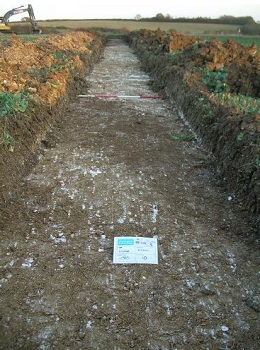Wixoe to Kirtling Green Pipeline. Archaeological Evaluation
Birmingham Archaeology, 2017. https://doi.org/10.5284/1046266. How to cite using this DOI
- Birmingham Archaeology (BUFAU) Digital Archives
- Suffolk County Council Archaeological Service Digital Archives
Data copyright © University of Birmingham unless otherwise stated
This work is licensed under the ADS Terms of Use and Access.
Primary contact
Historic England
1 Waterhouse Square
138-142 Holborn
London
EC1N 2ST
UK
Tel: 01793 414700
Fax: 01793 414707
Resource identifiers
- ADS Collection: 2949
- DOI:https://doi.org/10.5284/1046266
- How to cite using this DOI
Introduction

In September 2009 Birmingham Archaeology was commissioned by Suffolk and Essex Water to undertake an archaeological evaluation in advance of a proposed pipeline between Wixoe and Kirtling Green, Suffolk. This archive records the results of the evaluation and highlights areas of archaeological significance. At Wixoe, cropmarks and previous fieldwalking identified dense concentrations of artefacts dating to the Romano-British period. A geophysical survey identified distinct structures along with large pit like anomalies. The features identified by the evaluation consisted of pits and postholes as well as linear ditches and were sealed by a thick layer of buried soil which contained dense concentrations of tile and pottery as well as metalwork. This Roman activity continued to the north in Field 2 with several ditches and what appeared to be possible structures with associated cobbled surfaces.
Fields 13-16 showed evidence of sparse prehistoric and Roman activity that was sealed by a layer of colluvium. This activity is spread over a wide area and is not considered to be a discrete area of occupation.
Prehistoric activity was recorded between fields 25-27, with a large triple ditch feature in Field 27 yielding large quantities of pottery and animal bone. In association with this was a calf burial. In Field 28 several ditch features were excavated which contained small amounts of prehistoric pottery and may be a continuation of the activity seen in Field 27. The geophysical survey in Field 26 recorded a number of discreet features including several ditch features and layers of possible occupation debris dating from the Roman and medieval periods. The changes in slope direction in the field indicated radically different thicknesses of colluvial overburden which varied from trench to trench, and in some cases the natural was not reached. Medieval activity recorded in Fields 39 and 41 was probably associated with the deserted medieval village of Little Bradley, situated nearby. Field 41 also included a cremation burial probably dating to the Late Bronze Age which, although isolated, may be part of a larger cremation cemetery.
The field at the northern end of the pipeline contained post medieval activity which related to the former enclosures of the Great Bradley estate. This however does not tally with the Roman finds recovered from the topsoil during the programme of fieldwalking.







